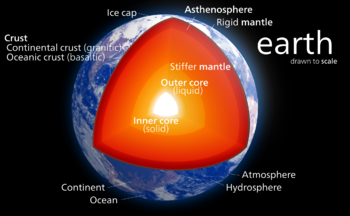Earth:Mantle (geology)
A mantle is a layer inside a planetary body bounded below by a core and above by a crust. Mantles are made of rock or ices, and are generally the largest and most massive layer of the planetary body. Mantles are characteristic of planetary bodies that have undergone differentiation by density. All terrestrial planets (including Earth), a number of asteroids, and some planetary moons have mantles.
Examples
Earth
The Earth's mantle is a layer of silicate rock between the crust and the outer core. Its mass of 4.01 × 1024 kg is 67% the mass of the Earth.[1] It has a thickness of 2,900 kilometres (1,800 mi)[1] making up about 84% of Earth's volume. It is predominantly solid, but in geological time it behaves as a viscous fluid. Partial melting of the mantle at mid-ocean ridges produces oceanic crust, and partial melting of the mantle at subduction zones produces continental crust.[2]
Other planets
Mercury has a silicate mantle approximately 490 kilometers (300 miles) thick, constituting only 28% of its mass.[1] Venus's silicate mantle is approximately 2,800 kilometers (1,700 miles) thick, constituting around 70% of its mass.[1] Mars's silicate mantle is approximately 1,600 kilometers (990 miles) thick, constituting ~74–88% of its mass,[1] and may be represented by chassignite meteorites.[3]
Moons
Jupiter's moons Io, Europa, and Ganymede have silicate mantles; Io's ~1,100 kilometers (680 miles) silicate mantle is overlain by a volcanic crust, Ganymede's ~1,315 kilometers (817 miles) thick silicate mantle is overlain by ~835 kilometers (519 miles) of ice, and Europa's ~1,165 kilometers (724 miles) km silicate mantle is overlain by ~85 kilometers (53 miles) of ice and possibly liquid water.[1]
The silicate mantle of the Earth's moon is approximately 1300–1400 km thick, and is the source of mare basalts.[4] The lunar mantle might be exposed in the South Pole-Aitken basin or the Crisium basin.[4] The lunar mantle contains a seismic discontinuity at ~500 kilometers (310 miles) depth, most likely related to a change in composition.[4]
Titan and Triton each have a mantle made of ice or other solid volatile substances.[5][6]
Asteroids
Some of the largest asteroids have mantles;[7] for example, Vesta has a silicate mantle similar in composition to diogenite meteorites.[8]
See also
- Earth's internal heat budget
- Lehmann discontinuity
- Mantle xenoliths
- Mantle convection
- Mesosphere (mantle)
- Numerical modeling (geology)
- Primitive mantle
References
- ↑ 1.0 1.1 1.2 1.3 1.4 1.5 Katharina., Lodders (1998). The planetary scientist's companion. Fegley, Bruce.. New York: Oxford University Press. ISBN 978-1423759836. OCLC 65171709.
- ↑ "What is the Earth's Mantle Made Of? – Universe Today" (in en-US). Universe Today. 2016-03-26. https://www.universetoday.com/40229/what-is-the-earths-mantle-made-of/.
- ↑ Swindle, T. D. (2002-01-01). "Martian Noble Gases" (in en). Reviews in Mineralogy and Geochemistry 47 (1): 171–190. doi:10.2138/rmg.2002.47.6. ISSN 1529-6466. Bibcode: 2002RvMG...47..171S. https://pubs.geoscienceworld.org/msa/rimg/article-abstract/47/1/171/235381/martian-noble-gases?redirectedFrom=fulltext.
- ↑ 4.0 4.1 4.2 Wieczorek, M. A. (2006-01-01). "The Constitution and Structure of the Lunar Interior" (in en). Reviews in Mineralogy and Geochemistry 60 (1): 221–364. doi:10.2138/rmg.2006.60.3. ISSN 1529-6466. Bibcode: 2006RvMG...60..221W. https://pubs.geoscienceworld.org/msa/rimg/article-abstract/60/1/221/140775/the-constitution-and-structure-of-the-lunar?redirectedFrom=fulltext.
- ↑ "Layers of Titan". NASA. 23 February 2012. http://saturn.jpl.nasa.gov/photos/imagedetails/index.cfm?imageId=4468.
- ↑ "Triton: In Depth". NASA. http://solarsystem.nasa.gov/planets/triton/indepth.
- ↑ "Griffith Observatory – Pieces of the Sky – Meteorite Histories" (in en-us). http://www.griffithobservatory.org/exhibits/edgeofspace_piecesofthesky-histories.html.
- ↑ Reddy, Vishnu; Nathues, Andreas; Gaffey, Michael J. (2011-03-01). "First fragment of Asteroid 4 Vesta's mantle detected" (in en). Icarus 212 (1): 175–179. doi:10.1016/j.icarus.2010.11.032. ISSN 0019-1035. Bibcode: 2011Icar..212..175R.
Further reading
- Don L. Anderson, Theory of the Earth, Blackwell (1989), is a textbook dealing with the Earth's interior and is now available on the web. Retrieved 2007-12-23.
- Jeanloz, Raymond (2000). "Mantle of the Earth". in Haraldur Sigurdsson. Encyclopedia of Volcanoes. San Diego: Academic Press. pp. 41–54. ISBN 978-0-12-643140-7.
- Nixon, Peter H. (1987). Mantle xenoliths: J. Wiley & Sons, 844p., (ISBN:0-471-91209-3).
- Donald L. Turcotte and Gerald Schubert, Geodynamics, Cambridge University Press , Third Edition (2014), ISBN:978-1-107-00653-9 (Hardback) ISBN:978-0-521-18623-0 (Paperback)
External links
- The Biggest Dig: Japan builds a ship to drill to the earth's mantle – Scientific American (September 2005) (archived 17 October 2007)
- Information on the Mohole Project (archived 2 November 2015)
 |


